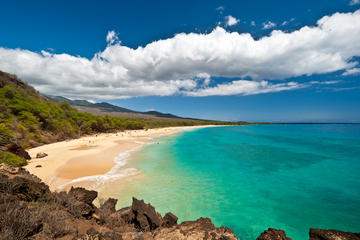Makena
TIME : 2016/2/22 16:49:10

Makena
Makena has the notorious distinction of being the first place where a Western explorer set foot on the island of Maui. When Jean Francois de La Perouse first “discovered” the island of Maui in 1786, he found a thriving population of Native Hawaiians living along this volcanic shoreline. Unlike areas of South Maui such as Kihei and Wailea which are so developed today, Makena was the population center for South Maui’s original inhabitants, and consequently, it’s an area which is heavily steeped in ancient history and culture.
Although much of modern Makena has been developed with resorts and homes, this history is still evident at places such as Keawala’i Church—a Congregational Church established in 1832—where sermons are still held in the Hawaiian language. Similarly, at the end of the paved road in Keone’o’io Bay (La Perouse Bay), the trailhead begins for the ancient King’s Highway, a rocky path commissioned by King Pi’ilani which once wrapped its way around the entire island.
You can also find great snorkeling in Makena, and pods of spinner dolphins have been known to frequent the waters of Keone’o’io. For beaches, Makena is home to “Big Beach”, which aside from being one of the island’s most popular beaches is one of the only stretches of Maui’s shoreline which has been entirely protected from development. Across a small hill on the north end of the beach, “Little Beach” is known as the island’s “clothing-optional” outpost, and legions of sun-worshipping hippies host weekly drum circles which are heavy on fire dancing and thin on clothing.
Makena is also the site of the island’s last volcanic eruption, and geologists have tentatively settled on 1790 as the last eruption of Haleakala volcano. Driving the road out towards Keone’o’io Bay, visitors can look up the mountainside to see the area where lava last weaved its way down towards shore. Like a big black tongue lapping its way across the kiawe trees, the black ribbon of volcanic rock serves as a reminder of how these islands were formed.
Although Makena is only a ten-minute drive from the mega-resorts of nearby Wailea, it manages to retain a rural charm that draws everyone from hikers to hippies and surfers to sightseers. It’s a dry, volcanic stretch of rocky shore where you can still catch glimpses of the island’s past which once thrived along the southern coast.
